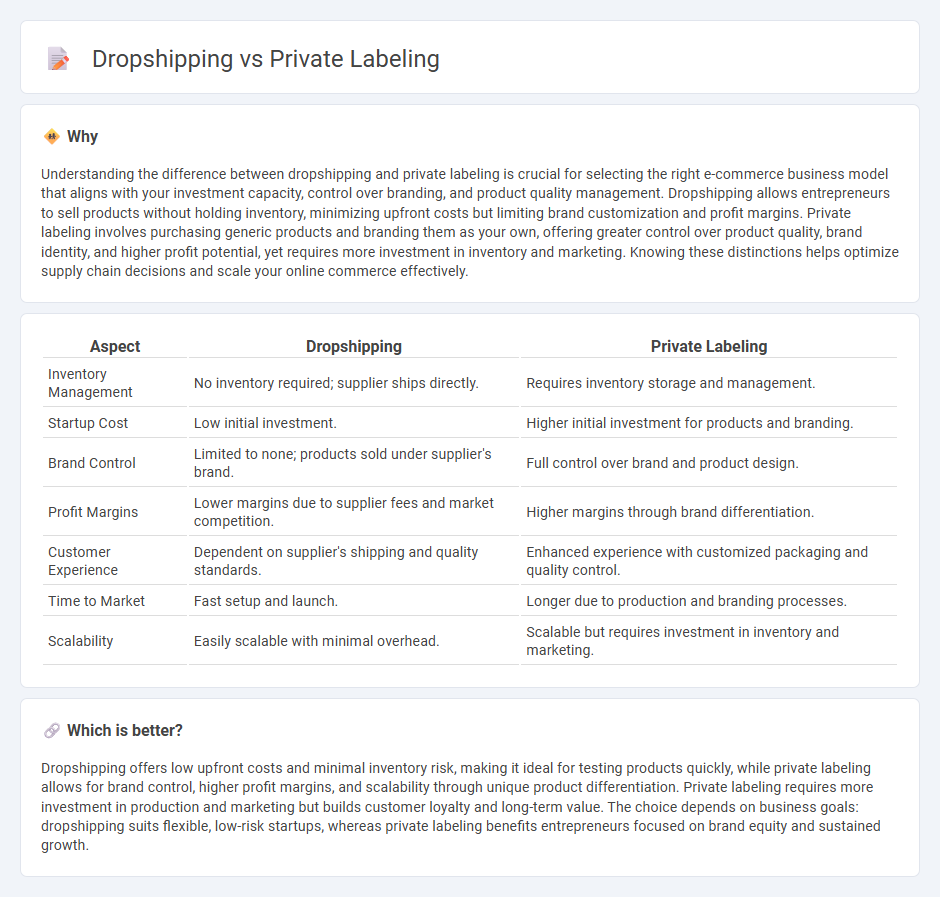
Dropshipping allows retailers to sell products without maintaining inventory, using third-party suppliers who ship directly to customers, minimizing upfront investment and operational complexity. Private labeling involves creating custom-branded products manufactured by a third party, offering greater control over branding, quality, and profit margins but requiring higher initial capital and inventory management. Explore the advantages and challenges of dropshipping versus private labeling to determine the best e-commerce strategy for your business goals.
Why it is important
Understanding the difference between dropshipping and private labeling is crucial for selecting the right e-commerce business model that aligns with your investment capacity, control over branding, and product quality management. Dropshipping allows entrepreneurs to sell products without holding inventory, minimizing upfront costs but limiting brand customization and profit margins. Private labeling involves purchasing generic products and branding them as your own, offering greater control over product quality, brand identity, and higher profit potential, yet requires more investment in inventory and marketing. Knowing these distinctions helps optimize supply chain decisions and scale your online commerce effectively.
Comparison Table
| Aspect | Dropshipping | Private Labeling |
|---|---|---|
| Inventory Management | No inventory required; supplier ships directly. | Requires inventory storage and management. |
| Startup Cost | Low initial investment. | Higher initial investment for products and branding. |
| Brand Control | Limited to none; products sold under supplier's brand. | Full control over brand and product design. |
| Profit Margins | Lower margins due to supplier fees and market competition. | Higher margins through brand differentiation. |
| Customer Experience | Dependent on supplier's shipping and quality standards. | Enhanced experience with customized packaging and quality control. |
| Time to Market | Fast setup and launch. | Longer due to production and branding processes. |
| Scalability | Easily scalable with minimal overhead. | Scalable but requires investment in inventory and marketing. |
Which is better?
Dropshipping offers low upfront costs and minimal inventory risk, making it ideal for testing products quickly, while private labeling allows for brand control, higher profit margins, and scalability through unique product differentiation. Private labeling requires more investment in production and marketing but builds customer loyalty and long-term value. The choice depends on business goals: dropshipping suits flexible, low-risk startups, whereas private labeling benefits entrepreneurs focused on brand equity and sustained growth.
Connection
Dropshipping and private labeling are connected through their shared reliance on supply chain management to facilitate product sourcing and distribution without holding inventory. Both methods enable entrepreneurs to enter e-commerce markets with reduced upfront costs, leveraging third-party suppliers or manufacturers to fulfill orders. Private labeling adds brand customization to the dropshipping model, allowing sellers to create unique products while outsourcing fulfillment.
Key Terms
Inventory Management
Private labeling requires maintaining control over inventory, ensuring stock accuracy, and managing warehousing costs to meet customer demand efficiently. Dropshipping eliminates direct inventory handling by relying on suppliers to store and ship products, reducing upfront investment but risking stock availability and delivery delays. Explore in-depth strategies for inventory management in private labeling and dropshipping to optimize your e-commerce operations.
Branding Control
Private labeling offers complete branding control by allowing businesses to design and market products under their own brand name, ensuring consistent brand identity and customer loyalty. Dropshipping limits branding opportunities as products are shipped directly from suppliers, often without customization or packaging unique to the retailer. Discover how branding control impacts business growth and customer perception by exploring the detailed differences between private labeling and dropshipping.
Profit Margins
Private labeling offers higher profit margins by allowing brands to control product quality and pricing, reducing costs associated with middlemen. Dropshipping minimizes upfront investment and inventory risks but often results in lower profit margins due to supplier fees and competitive pricing. Explore detailed strategies to maximize profits in both private labeling and dropshipping models.
Source and External Links
What Is a Private Label? How Private Labels Work in 2025 - Shopify - Private labeling is a branding arrangement where a company sells products manufactured by another company under its own brand, allowing retailers to offer exclusive, customized products while outsourcing manufacturing.
Private Labeling vs. White Labeling: What's the Difference? - Indeed - Private labeling involves exclusive products made for a retailer who controls branding and marketing, providing advantages like customization, better pricing control, and reduced competition.
Private label - Wikipedia - A private label is a product made by one company for another company to sell under its own brand, usually exclusively, differentiating from white-label products which are generic and sold to multiple brands.
 dowidth.com
dowidth.com